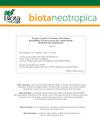One more place to call home: the invasive bivalve Mytilopsis leucophaeata reaches the Maricá-Guarapina lagoon system (Rio de Janeiro, Brazil)
IF 1.2
4区 环境科学与生态学
Q3 BIODIVERSITY CONSERVATION
引用次数: 0
Abstract
Abstract Mytilopsis leucophaeata is an estuarine bivalve native from the Gulf of Mexico and Southeast USA, and it was introduced in Europe, Asia, Caribbean, South America and Northeast USA, showing massive colonization skills. In Brazil, the single invasion records of M. leucophaeata occur in the city of Rio de Janeiro, i.e., in the Rodrigo de Freitas Lagoon and in the Marapendi Lagoon. We conducted a new series of fieldworks in estuaries from the Rio de Janeiro state in order to evaluate the propagation of this invasive bivalve, aiming sites with proper salinities for the establishment of M. leucophaeata. A new record is given for the Maricá-Guarapina lagoon system, where M. leucophaeata mainly colonizes hard substrata (such as piers and rocks), reaching a mean density up to 43,375 specimens/m2; however, aggregates of M. leucophaeata were also observed in the soft substratum. Based on mitochondrial sequences, the taxonomic identification of the invasive bivalve was confirmed. The associated fauna to the agglomerates of M. leucophaeata in the lagoon system comprises amphipods, barnacles, tanaidaceans, isopods, crabs, polychaetes and snails. The expansion of M. leucophaeata requires a continuous investigation due to the great circulation of boats in the littoral of the Rio de Janeiro state and the increased chance of new introductions.又多了一个可以称之为家的地方:入侵的双壳类动物白带Mytilopsis到达Maricá-Guarapina泻湖系统(巴西里约热内卢)
摘要白带mytillopsis leucophaeata是一种原产于墨西哥湾和美国东南部的河口双壳类动物,曾被引入欧洲、亚洲、加勒比海、南美洲和美国东北部,表现出大规模的殖民能力。在巴西,M. leucophaeata的单一入侵记录出现在里约热内卢市,即Rodrigo de Freitas Lagoon和Marapendi Lagoon。为了评估这种入侵双壳类动物的繁殖情况,我们在里约热内卢州的河口进行了一系列新的野外调查,目标是在适宜的盐度地点建立白鳍双壳类动物。Maricá-Guarapina泻湖系统创造了新的记录,在那里,m.b leucophaeata主要寄生于坚硬的基质(如桥墩和岩石),平均密度达到43,375个/m2;然而,在软基质中也观察到白色分枝杆菌的聚集。根据线粒体序列,确定了该入侵双壳类动物的分类身份。在泻湖系统中,与leucophaeata菌群相关的动物群包括片足类、藤壶类、甲壳类、等足类、螃蟹、多毛类和蜗牛。由于里约热内卢州沿岸船只的大量循环以及新引入的机会增加,因此需要对白藻的扩张进行持续调查。
本文章由计算机程序翻译,如有差异,请以英文原文为准。
求助全文
约1分钟内获得全文
求助全文
来源期刊

Biota Neotropica
BIODIVERSITY CONSERVATION-
CiteScore
2.90
自引率
16.70%
发文量
0
审稿时长
4-8 weeks
期刊介绍:
BIOTA NEOTROPICA is an electronic, peer-reviewed journal edited by the Program BIOTA/FAPESP: The Virtual Institute of Biodiversity. This journal"s aim is to disseminate the results of original research work, associated or not to the program, concerned with characterization, conservation and sustainable use of biodiversity within the Neotropical region.
Manuscripts are considered on the understanding that their content has not appeared, or will not be submitted, elsewhere in substantially the same form, because once published their copyrights are transferred to BIOTA NEOTROPICA as established in the Copyright Transfer Agreement signed by the author(s).
 求助内容:
求助内容: 应助结果提醒方式:
应助结果提醒方式:


